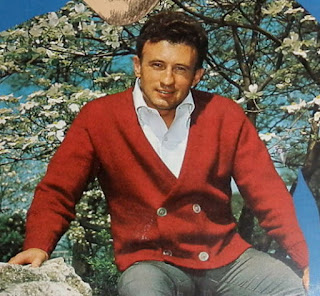Claudia Thompson (31 December, 1936 – 30 July. 2020) was a mysterious jazz singer who for nearly 60 years, was only known by her one album, until a discovery pushed a new record label to right the wrongs of history.
Claudia Thompson’s parents separated when she was young and growing up in Los Angeles, her mother would soon have dreams of fancy about becoming the mother of a Hollywood star. Claudia showed a natural ability to harmonize along with music and her mother began entering her into local talent contests. Claudia sang beautifully but had to fight a natural shyness. She was a light-skinned African American girl, and could quickly become the center of attention -- whether she wanted to or not -- with her head of bright naturally blonde hair. Today she would have been seen as beautiful but it was the early 1950s and such physical characteristics -- along with her poor vision -- was enough to get her bused with the "other funny-looking kids" she later recalled.
 |
| Original cover photo |
Claudia learned to read music to accompany her natural singing ability and enjoyed to entertain in small groups and school choirs. Eventually her voice caught the attention of Ramey Idriss who signed her to a contract and was able to land her a record deal, and thus, "Goodbye to Love" was born. Recorded at the famous Capitol Records recording studio in Hollywood, everyone involved felt they had a hit on their hands. Barney Kessel even gave her a fatherly talk to make sure she didn't let the praise and success go to her head. "Remember there's a big world out there, with plenty of danger and pitfalls lurking about," he cautioned her.
Claudia may have been bracing for success, but the first sign that things wouldn't work out was when a white model was chosen for the album cover rather than Claudia herself. She felt "terribly hurt" by the decision but was warned "not to make trouble" over it. But squabbles among record executives outside her control sank the album further. Jack Ames, the album's producer and owner of Edison International, didn't get along with the distributor, resulting in record stores not having the album in stock. A local jazz radio station would play songs from the record, but it did little good when no one could find it for sale. With the only records leaving the warehouse being the ones Claudia herself was taking for self-promotion, Ames eventually axed the record altogether. Stuck in limbo, Claudia paid Ramey Idriss to get out of her contract.
But failure wasn't something Claudia dwelled on. Not long after "Goodbye to Love," she met another fellow jazz singer named Ira Thomas. They began dating and hit it off right away, but Ira wanted to move to New York to further his career. Neither had ever been to NYC but took a chance and thus began the start of a multi-year, globe-trotting career for the duo. They would marry in 1962 in New York, shortly before leaving for Europe. From there they toured in the UK, France, and Germany, singing jazz standards. They also went to Asia spending time in Bangkok, Japan, and even a very brief USO stint in Saigon. By about 1968 they got an offer to perform back in the states, which would let them be closer to family in Los Angeles once again. They left years earlier with only $500 to their name. They were coming back home... now with $250 total instead.
Their musical careers back home weren't much more successful and by the 1970s they had to get "real jobs" and put their singing on hold. It wasn't until the late 1980s that the itch to perform came back, and they again began to tour the jazz circuit, spending time in the 1990s in Austin, Texas; Valencia, Spain; and finally, Las Vegas, Nevada, where they would ultimately retire. The couple maintained a website where Claudia wrote essays and they sold CDs and books of their work.
Ira would pass away at the age of 80 on September 4, 2014, leaving Claudia to maintain the site on her own. The website did have a blog section that Claudia would occasionally update on. If she had seen a news story about #FindTheGirlsOnTheNegatives, she gave no acknowledgment of it. Ira and Claudia never had any children, so it's possible without a connection to the younger generation rediscovering "Goodbye to Love," they were completely oblivious to its crate-digger status.
Claudia sold CD copies of "Goodbye to Love" but seemed unaware of the Modern Harmonic reissue in 2016. The Internet can be an amazing tool to find and connect with folks from all over the world. It's tragic that here was Claudia Thomas, maintaining her and her husband's website online, but still largely unseen. The start of the pandemic in March of 2020 had Claudia remark on her blog that it looked like "we are all in for a big outrageous time." She later noted a planned "bucket list gig" would have to be done as a video instead. Her final blog post on May 6, 2020, had her asking for help on how she could get her video online. "All for now!!!" she wrote. "Any of u out there who could help please let me know."
Claudia never finished her
video. She passed away two months later, on July 30, 2020, at the age of 83. No
one wrote Claudia T. Thomas an obituary. Just over a year after her death,
"Goodbye to Love" would be reissued, her face gracing the cover for
the very first time. 60+ years overdue and tragically, just a year too late.
(Edited from an article by
News Fedora @ Needles and Grooves Forum)





































.jpg)










